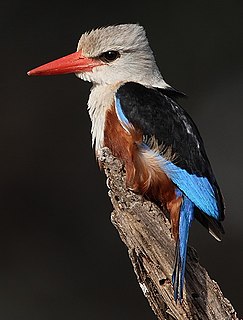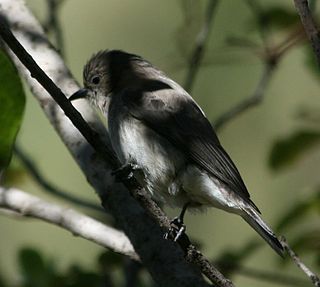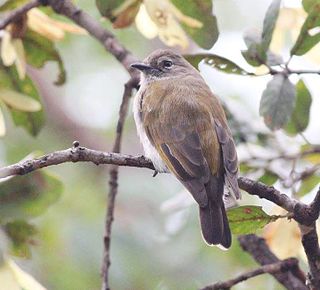
Honeyguides are near passerine birds in the order Piciformes. They are also known as indicator birds, or honey birds, although the latter term is also used more narrowly to refer to species of the genus Prodotiscus. They have an Old World tropical distribution, with the greatest number of species in Africa and two in Asia. These birds are best known for their interaction with humans. Honeyguides are noted and named for one or two species that will deliberately lead humans directly to bee colonies, so that they can feast on the grubs and beeswax that are left behind.

The greater honeyguide is a bird in the family Indicatoridae, paleotropical near passerine birds related to the woodpeckers. Its English and scientific names refer to its habit of guiding people to bee colonies. Claims that it also guides non-human animals are disputed.

The African paradise flycatcher is a medium-sized passerine bird. The two central tail feathers of the male are extended into streamers that commonly are more than twice as long as the body. The female tail feathers are of moderate length and without streamers. The upper parts of the male body, wings, and tail are boldly coloured in chestnut or rusty shades, but the underparts and the head are variably grey to blue-gray, with the head of the mature male being darker, commonly glossy black with greenish highlights. The beak and other bare areas, including a wattle ring round the eye, match the colour of the surrounding feathers. The female coloration is similar, though not so showy and glossy and with the head paler.

The black-necked weaver is a resident breeding bird species in much of tropical Africa from Senegal and northern Angola to South Sudan and Tanzania.

The yellow-rumped honeyguide is a sparrow-sized bird in the honeyguide family that is found in Asia, mainly in montane forests along the Himalayas. They are very finch-like but the feet are strong and zygodactyl, with two toes facing forward and two backward. They perch on honeycombs and feed on wax. Males tend to be territorial and stay near honeycombs while females and juveniles forage widely. They are brood parasites, laying their eggs in the nests of tree-hole breeders, possibly barbets.

The red-and-yellow barbet is a species of African barbet found in eastern Africa. Males have distinctive black, red, and yellow plumage; females and juveniles are similar, but less brightly colored. The species lives in broken terrain and nests and roosts in burrows. Omnivorous, the species feeds on seeds, fruit, and invertebrates. Where not hunted, they are tame, but their feathers are used by certain tribes, such as the Maasai.

The grey-headed kingfisher has a wide distribution from the Cape Verde Islands off the north-west coast of Africa to Mauritania, Senegal and Gambia, east to Ethiopia, Somalia and southern Arabia and south to South Africa.

The rufous-naped lark or rufous-naped bush lark is a widespread and conspicuous species of lark in the lightly wooded grasslands, open savannas and farmlands of the Afrotropics. Males attract attention to themselves by their bold and repeated wing-fluttering displays from prominent perches, which is accompanied by a melodious and far-carrying whistled phrase. This rudimentary display has been proposed as the precursor to the wing-clapping displays of other bush lark species. They have consistently rufous outer wings and a short erectile crest, but the remaining plumage hues and markings are individually and geographically variable. It has a straight lower, and longish, curved upper mandible.

The honeyguide greenbul is a species of songbird in the bulbul family, Pycnonotidae. It is widespread throughout the African tropical rainforest.

The white-bellied bustard or white-bellied korhaan is an African species of bustard. It is widespread in sub-Saharan Africa in grassland and open woodland habitats.

The marsh tchagra or blackcap bush-shrike is a species of passerine bird placed in the monotypic genus Bocagia in the family Malaconotidae. It is native to marshes in the tropics and subtropics of Africa. It is sometimes placed in the genus Tchagra.
The least honeyguide is a species of bird in the family Indicatoridae. It is found in Angola, Cameroon, Central African Republic, Republic of the Congo, Democratic Republic of the Congo, Ivory Coast, Equatorial Guinea, Gabon, Ghana, Guinea, Guinea-Bissau, Kenya, Liberia, Nigeria, Rwanda, Sierra Leone, South Sudan, Tanzania, Togo, Uganda, and Zambia.

The lesser honeyguide is a species of bird in the family Indicatoridae.

The scaly-throated honeyguide is a species of bird in the family Indicatoridae.

Willcocks's honeyguide is a species of bird in the family Indicatoridae. It is found mainly throughout the African tropical rainforest.
The yellow-footed honeyguide is a species of bird in the family Indicatoridae. It is found in Cameroon, Guinea, Liberia, Sierra Leone, Ivory Coast, Ghana and Nigeria. Its natural habitat is subtropical or tropical moist lowland forests. It is threatened by loss of its forest habitat.

The brown-backed honeybird, also known as Wahlberg's honeybird, Wahlberg's honeyguide and sharp-billed honeyguide, is a species of bird in the family Indicatoridae. This bird is named after the Swedish naturalist Johan August Wahlberg.

The green-backed honeybird, also known as the eastern green-backed honeyguide, green-backed honeyguide and slender-billed honeyguide, is a species of bird in the family Indicatoridae.

The hairy-breasted barbet is a species of bird in the family Lybiidae. It is found throughout the Africa tropical rainforest.

The thick-billed honeyguide is a bird of the honeyguide family Indicatoridae. It has been reported interbreeding with the related lesser honeyguide and the two are sometimes treated as a single species.



















